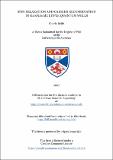Files in this item
Spin relaxation and carrier recombination in GaInNAs multiple quantum wells
Item metadata
| dc.contributor.advisor | Miller, Alan | |
| dc.contributor.author | Reith, Charis | |
| dc.coverage.spatial | 133 p. | en |
| dc.date.accessioned | 2007-02-05T11:42:46Z | |
| dc.date.available | 2007-02-05T11:42:46Z | |
| dc.date.issued | 2007-06 | |
| dc.identifier.uri | https://hdl.handle.net/10023/160 | |
| dc.description.abstract | Electron spin relaxation and carrier recombination were investigated in gallium indium nitride arsenide (GaInNAs) multiple quantum wells, using picosecond optical pulses. Pump-probe experiments were carried out at room temperature, using pulses produced by a Ti:sapphire pumped optical parametric oscillator. The peak wavelengths of the excitonic resonances for the quantum well samples were identified using linear absorption measurements, and were found to be in the range 1.25µm-1.29µm. Carrier recombination times were measured for three samples of varying nitrogen content, and were observed to decrease from 548 to 180ps as nitrogen molar fractions were increased in the range 0.45-1.24%. Carrier recombination times were also measured for samples which had undergone a post-growth annealing process, and were found to be signicantly shorter compared to times measured for as-grown samples. Electron spin relaxation time was investigated for samples with quantum well widths in the range 5.8-8nm, and was found to increase with increasing well width, (i.e. decreasing quantum confinement energy), a trend predicted by both D'Yakonov-Kachorovskii and Elliott-Yafet models of spin relaxation in quantum wells. In a further study, longer spin relaxation times were exhibited by samples containing higher molar fractions of nitrogen, but having nominally constant quantum well width. Spin relaxation times increased from 47ps to 115ps for samples containing nitrogen concentrations in the range 0.45-1.24%. Decreases in spin relaxation time were observed in the case of those samples which had been annealed post-growth, compared to as-grown samples. Finally, all-optical polarisation switching based on spin relaxation of optically generated carriers in GaInNAs multiple quantum wells was demonstrated. | en |
| dc.format.extent | 20161463 bytes | |
| dc.format.mimetype | application/pdf | |
| dc.language.iso | en | en |
| dc.publisher | University of St Andrews | |
| dc.rights | Creative Commons Attribution-NoDerivs 2.5 Generic | |
| dc.rights.uri | http://creativecommons.org/licenses/by-nd/2.5/ | |
| dc.subject | Spin relaxation | en |
| dc.subject | Carrier recombination | en |
| dc.subject | GaInNAs | en |
| dc.subject | Quantum wells | en |
| dc.subject.lcc | QC611.8G3R4 | |
| dc.subject.lcsh | Electron paramagnetic resonance | en |
| dc.subject.lcsh | Semiconductors--Recombination | en |
| dc.subject.lcsh | Gallium arsenide semiconductors | en |
| dc.subject.lcsh | Quantum wells | en |
| dc.title | Spin relaxation and carrier recombination in GaInNAs multiple quantum wells | en |
| dc.type | Thesis | en |
| dc.type.qualificationlevel | Doctoral | en |
| dc.type.qualificationname | PhD Doctor of Philosophy | en |
| dc.publisher.institution | The University of St Andrews | en |
This item appears in the following Collection(s)
Except where otherwise noted within the work, this item's licence for re-use is described as Creative Commons Attribution-NoDerivs 2.5 Generic
Items in the St Andrews Research Repository are protected by copyright, with all rights reserved, unless otherwise indicated.


